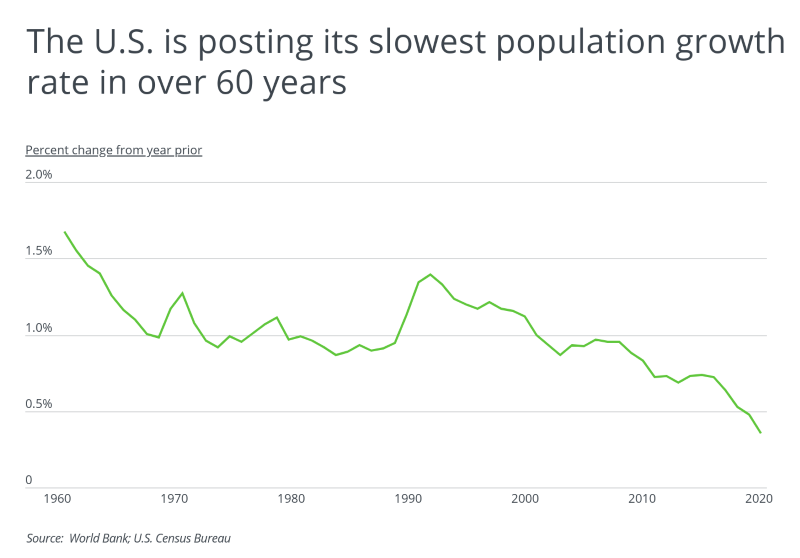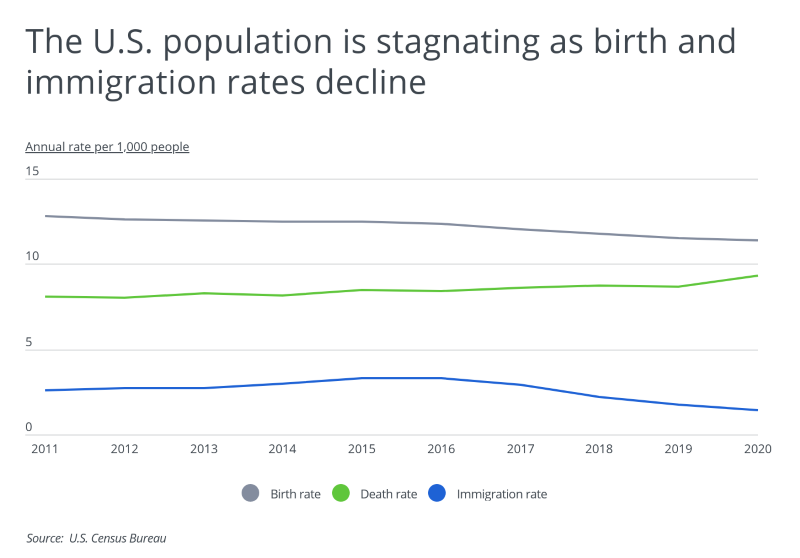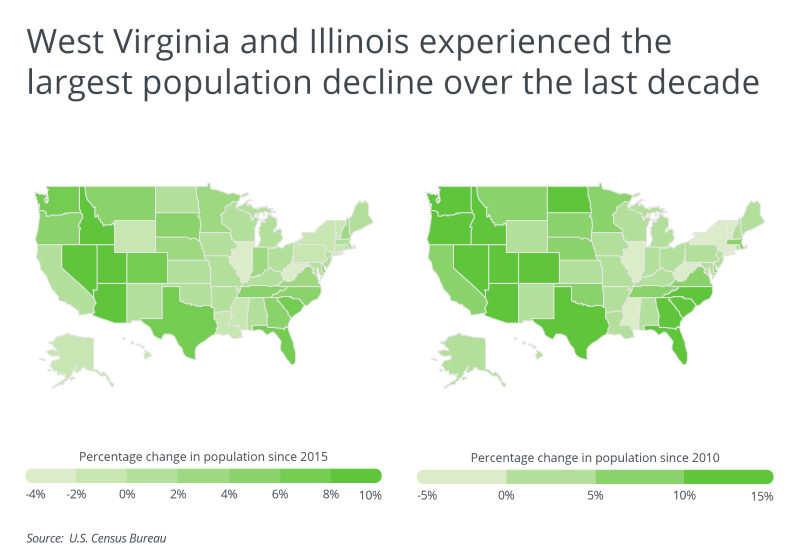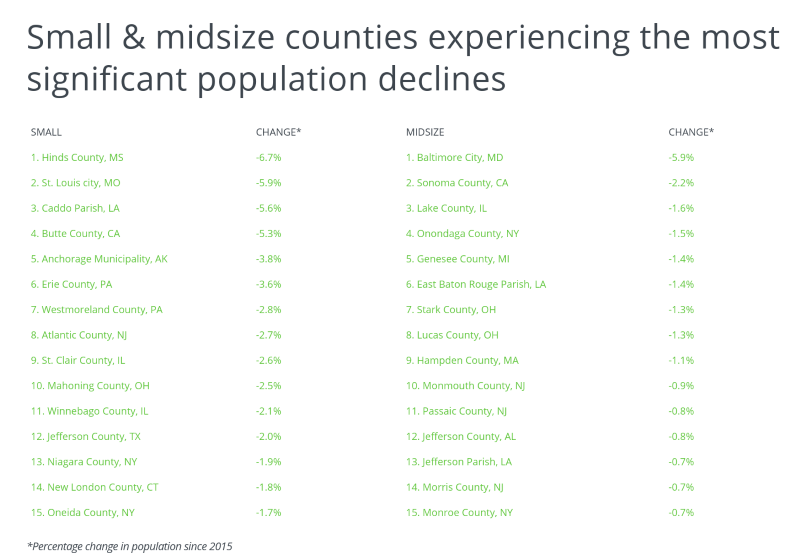The US Counties Experiencing the Sharpest Population Declines since the Trump Administration
 Photo Credit: Alamy Stock Photo
Photo Credit: Alamy Stock Photo
June 22nd, 2021
For the first time ever, California posted a population decline in 2020, and the United States as a whole didn't fare much better. Its growth has decelerated to 0.35% year-over-year, the slowest growth rate since the Great Depression.
Population experts blame the slowing growth rate on three big trends: families across the country are aging and having fewer kids, immigration policies have tightened up American borders, and economic hardships extending back to the dot-com crash and the Great Recession have shifted priorities away from marriage and families. While some contributing factors are down across the board, other social and economic factors have disproportionately impacted specific counties and states, exacerbating the problems for certain areas.

This latest decline in population growth at the national level is primarily the result of a lower birth rate and reduced immigration during the Trump administration. The U.S. birth rate has slowed for six years in a row to 11.4 births per 1,000 people in 2020—resulting in the fewest births since 1979, according to the Centers for Disease Control (CDC). From 2019 to 2020, the rate slowed 4%, which was twice as fast as the average slowdown since 2014. It was spread across all age groups of women, though the birth rate for teenagers aged 15 to 19 slowed 8%.
Meanwhile, the growth in immigration peaked in 2015, plateaued in 2016 at 3.3 immigrants per thousand residents, and has slowed markedly in line with new federal immigration policies implemented in 2017. The 2020 rate was down to 1.5 immigrants per thousand.

Since 2010, the population totals of only six states declined, and of those only West Virginia (down 3.7%) and Illinois (down 2%) dropped by more than 1%. It's a different story over the last five years, though. In addition to West Virginia and Illinois, states losing 1% or more of their population were New York, Hawaii, and Alaska.
In West Virginia, the struggle is primarily with an aging rural population. There are more deaths than births in the state, and rural counties are shrinking nearly three times as fast as urban counties, according to the West Virginia Center on Budget & Policy. In Illinois, the population loss has accelerated for seven straight years, per Illinois Policy, due primarily to a lack of housing and employment opportunities, as well as high taxes.
Persistent population loss creates compounding economic, social, and political challenges for the residents who remain. West Virginia and Illinois are among just seven states that recently lost a congressional seat as a result of the 2020 Census population estimates. Other states losing a seat include New York, California, Pennsylvania, Ohio, and Michigan.

Zooming in on the county level, urban centers stand out for being hardest hit with population loss. CBRE Group research shows that urban centers were the only neighborhood type to see more people move out in 2020 than move in, and it underscores a trend that's been a decade in the making.
To find the counties with the most significant population declines, researchers calculated the percentage change in population based on U.S. Census estimates since 2015. To improve relevance, only counties with at least 200,000 residents were included. Additionally, counties were grouped into cohorts based on population size: small (200,000–349,999), midsize (350,000–749,999), and large (750,000 or more).
Here are the counties with the most significant population declines over the past five years.

Large Counties Experiencing the Most Significant Population Declines
 Photo Credit: Alamy Stock Photo
Photo Credit: Alamy Stock Photo15. San Mateo County, CA
- Metro: San Francisco-Oakland-Berkeley, CA
- Percentage change in population since 2015: -0.9%
- Percentage change in population since 2010: +5.3%
- Total change in population since 2015: -7,171
- Total change in population since 2010: +38,360
- Population 2020: 758,308
- Population 2015: 765,479
- Population 2010: 719,948
 Photo Credit: Alamy Stock Photo
Photo Credit: Alamy Stock Photo14. New Haven County, CT
- Metro: New Haven-Milford, CT
- Percentage change in population since 2015: -1.0%
- Percentage change in population since 2010: -1.3%
- Total change in population since 2015: -8,558
- Total change in population since 2010: -11,450
- Population 2020: 851,948
- Population 2015: 860,506
- Population 2010: 863,398
 Photo Credit: Alamy Stock Photo
Photo Credit: Alamy Stock Photo13. Suffolk County, NY
- Metro: New York-Newark-Jersey City, NY-NJ-PA
- Percentage change in population since 2015: -1.2%
- Percentage change in population since 2010: -1.3%
- Total change in population since 2015: -17,724
- Total change in population since 2010: -20,064
- Population 2020: 1,474,273
- Population 2015: 1,491,997
- Population 2010: 1,494,337
 Photo Credit: Alamy Stock Photo
Photo Credit: Alamy Stock Photo12. Los Angeles County, CA
- Metro: Los Angeles-Long Beach-Anaheim, CA
- Percentage change in population since 2015: -1.3%
- Percentage change in population since 2010: +1.2%
- Total change in population since 2015: -134,217
- Total change in population since 2010: +121,399
- Population 2020: 9,943,046
- Population 2015: 10,077,263
- Population 2010: 9,821,647
 Photo Credit: Alamy Stock Photo
Photo Credit: Alamy Stock Photo11. Wayne County, MI
- Metro: Detroit-Warren-Dearborn, MI
- Percentage change in population since 2015: -1.4%
- Percentage change in population since 2010: -4.1%
- Total change in population since 2015: -24,243
- Total change in population since 2010: -74,224
- Population 2020: 1,740,623
- Population 2015: 1,764,866
- Population 2010: 1,814,847
 Photo Credit: Alamy Stock Photo
Photo Credit: Alamy Stock Photo10. Milwaukee County, WI
- Metro: Milwaukee-Waukesha, WI
- Percentage change in population since 2015: -1.4%
- Percentage change in population since 2010: -0.3%
- Total change in population since 2015: -13,590
- Total change in population since 2010: -3,273
- Population 2020: 945,016
- Population 2015: 958,606
- Population 2010: 948,289
 Photo Credit: Alamy Stock Photo
Photo Credit: Alamy Stock Photo9. Allegheny County, PA
- Metro: Pittsburgh, PA
- Percentage change in population since 2015: -1.5%
- Percentage change in population since 2010: -1.0%
- Total change in population since 2015: -17,984
- Total change in population since 2010: -12,615
- Population 2020: 1,211,358
- Population 2015: 1,229,342
- Population 2010: 1,223,973
 Photo Credit: Alamy Stock Photo
Photo Credit: Alamy Stock Photo8. New York County, NY
- Metro: New York-Newark-Jersey City, NY-NJ-PA
- Percentage change in population since 2015: -1.5%
- Percentage change in population since 2010: +1.4%
- Total change in population since 2015: -25,338
- Total change in population since 2010: +22,948
- Population 2020: 1,611,989
- Population 2015: 1,637,327
- Population 2010: 1,589,041
 Photo Credit: Alamy Stock Photo
Photo Credit: Alamy Stock Photo7. DuPage County, IL
- Metro: Chicago-Naperville-Elgin, IL-IN-WI
- Percentage change in population since 2015: -1.7%
- Percentage change in population since 2010: -0.1%
- Total change in population since 2015: -16,188
- Total change in population since 2010: -515
- Population 2020: 917,481
- Population 2015: 933,669
- Population 2010: 917,996
 Photo Credit: Alamy Stock Photo
Photo Credit: Alamy Stock Photo6. Cuyahoga County, OH
- Metro: Cleveland-Elyria, OH
- Percentage change in population since 2015: -2.5%
- Percentage change in population since 2010: -3.9%
- Total change in population since 2015: -31,226
- Total change in population since 2010: -50,220
- Population 2020: 1,227,883
- Population 2015: 1,259,109
- Population 2010: 1,278,103
 Photo Credit: Alamy Stock Photo
Photo Credit: Alamy Stock Photo5. Cook County, IL
- Metro: Chicago-Naperville-Elgin, IL-IN-WI
- Percentage change in population since 2015: -2.6%
- Percentage change in population since 2010: -1.7%
- Total change in population since 2015: -135,087
- Total change in population since 2010: -90,693
- Population 2020: 5,108,284
- Population 2015: 5,243,371
- Population 2010: 5,198,977
 Photo Credit: Alamy Stock Photo
Photo Credit: Alamy Stock Photo4. Bronx County, NY
- Metro: New York-Newark-Jersey City, NY-NJ-PA
- Percentage change in population since 2015: -2.7%
- Percentage change in population since 2010: +1.0%
- Total change in population since 2015: -38,338
- Total change in population since 2010: +14,213
- Population 2020: 1,401,142
- Population 2015: 1,439,480
- Population 2010: 1,386,929
 Photo Credit: Alamy Stock Photo
Photo Credit: Alamy Stock Photo3. Kings County, NY
- Metro: New York-Newark-Jersey City, NY-NJ-PA
- Percentage change in population since 2015: -2.7%
- Percentage change in population since 2010: +1.2%
- Total change in population since 2015: -69,863
- Total change in population since 2010: +28,980
- Population 2020: 2,538,934
- Population 2015: 2,608,797
- Population 2010: 2,509,954
 Photo Credit: Alamy Stock Photo
Photo Credit: Alamy Stock Photo2. Honolulu County, HI
- Metro: Urban Honolulu, HI
- Percentage change in population since 2015: -2.8%
- Percentage change in population since 2010: +0.8%
- Total change in population since 2015: -27,929
- Total change in population since 2010: +7,506
- Population 2020: 963,826
- Population 2015: 991,755
- Population 2010: 956,320
 Photo Credit: Alamy Stock Photo
Photo Credit: Alamy Stock Photo1. Queens County, NY
- Metro: New York-Newark-Jersey City, NY-NJ-PA
- Percentage change in population since 2015: -3.4%
- Percentage change in population since 2010: -0.4%
- Total change in population since 2015: -79,431
- Total change in population since 2010: -8,753
- Population 2020: 2,225,821
- Population 2015: 2,305,252
- Population 2010: 2,234,574
Detailed Findings & Methodology
The data used in this analysis is from the U.S. Census Bureau's Population Estimates. To determine the locations experiencing the largest population decline, researchers calculated the percentage change in population since 2015. In the event of a tie, the percentage change in population since 2010 was used. To improve relevance, only counties with at least 200,000 residents were included. Additionally, counties were grouped into cohorts based on population size: small (200,000–349,999), midsize (350,000–749,999), and large (750,000 or more).